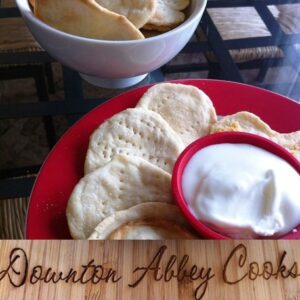
While first—and second-class guests dined on elaborate multi-course meals prepared by a skilled culinary staff, third-class guests had much simpler fare. The cabin biscuit, also called a ship’s biscuit or hardtack, was an important staple that could withstand long journeys at sea.
What Were Cabin Biscuits?
Cabin biscuits were crackers or simple bread made from flour, water, and sometimes a small amount of salt. The dough was rolled thin, cut into shapes, and baked until dry and hard. This simplified production and the lack of perishable ingredients allowed the biscuits to stay fresh for months when kept dry.
These tough crackers were certainly not intended as a delicacy. Instead, they were an affordable, long-lasting food source that provided carbohydrates. They could be filled by dunking them in water, coffee, tea, or soup to soften them up. Salted meat or fish often accompanied the biscuits.
Titanic’s Third Class Provisions
As a ship operating in the early 20th century, Titanic was required to stock enough non-perishable foods for every passenger and crew member in case of emergency delays. This included thousands of pounds of cabin biscuits in the bakery and food storage rooms.
For the 700+ third-class passengers booked in the most economical accommodations, meals in the dining saloon consisted primarily of biscuits and coffee, tea, porridge, hash, potatoes, and other simple, hearty staples. First-class guests, meanwhile, enjoyed luxuries like fresh bread, pastries, meats, vegetables, and elegantly prepared cuisine.
The cabin biscuit may have been quite plain. Still, it was essential to keeping the ship’s passengers and crew fed, especially in third class, where meals were designed to be affordable, filling and long-lasting rather than gourmet. So, while often taken for granted, the utilitarian ship’s biscuit played a vital role and was an authentic taste of ocean travel in 1912.
Titanic's Cabin Biscuits
Ingredients
- 2 cups Flour
- 1/2 tsp. salt
- 1 tsp. shortening
- 3/4 cup water
Instructions
- Mix the flour and salt together in a bowl.
- Work shortening into mixture until it resembles fine crumbs
- Make a well in the flour, add water and mix until you have have stiff dough. Add 1 or 2 additional tablespoons if required.
- Place on a lightly floured board and roll into a 1 inch diameter log/cylinder shape. Cut the log into 25 discs and place on a cookie sheet.
- Cover with clear plastic wrap and let rest for 15 minutes
- Roll each disk into 2 1/2 inch circles. Prick holes with a fork. Bake at 375°F for 15 minutes
Topping Variations
- Spray each unbaked biscuit with water and sprinkle with rock salt.
- Brush unbaked biscuits with melted butter then sprinke a mixture of cinammon and sugar.
- After 10 minutes sprinkle with parmesan cheese and chopped parsley, return to oven for an additional 5minutes.
